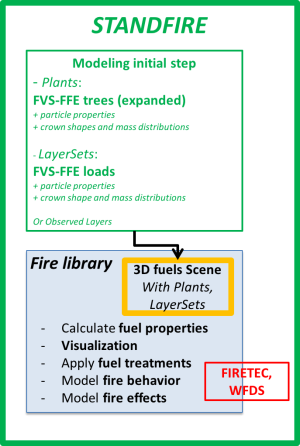Table of Contents
STANDFIRE
General objectives
Scientists and managers critically need ways to assess how fuel treatments alter fire behavior, yet few tools currently exist for this purpose. FIRETEC (Linn and Cunningham, 2005) and WFDS (Mell et al., 2007) recently emerged as promising models in this context since they explicitly account for 3D fuel structure, but there is a need for a tool to facilitate the development of heterogeneous landscape-scale fuel beds based on available data, to evolve these fuel beds to mimic nature processes and to manipulate the fuel beds based on anthropogenic or natural disturbances. Developed in collaboration with the Rocky Mountain Fire Station of the US Forest Service, STANDFIRE is designed to read outputs from FFE-FVS (Crookston and Dixon, 2005), which is one of the main US Forest Service growth model and to convert them in 3D input files for FIRETEC or WFDS. STANDFIRE can also be used to parametrize with greater details the understorey, but also to model fuel treatments, and fire effects. The module mostly relies on the fire library.
Quick start guide
References
Parsons RA, Pimont F, Wells L, Cohn G, Jolly WM, de Coligny F, Rigolot E, Dupuy J-L, Mell W, Linn RR. 2018. Modeling thinning effects on fire behavior with STANDFIRE. Annals of Forest Science 75, 1-10. 2018parsons.pdf
Pimont F, Parsons R, Rigolot E, Dupuy J-L, Coligny F, Linn R. 2016. Modeling Fuels and Fire Effects in 3D with FuelManager and STANDFIRE. International Association of Wildland Fire. Proceedings for the 5th International Fire Behavior and Fuels Conference, April 11-15, 2016, Portland, Oregon, USA. 6p. 112._francois_pimont-extendedabstract.pdf
Pimont F, Parsons R, Rigolot E, Coligny F, Dupuy J-L, Dreyfus P, Linn R. 2016. Modeling fuels and fire effects in 3D : model description and applications. Environmental Modelling and Software 80, 225-244. 2016_fuelmanager.pdf
Additionnal References
Linn, R.R., Cunningham, P., 2005. Numerical simulations of grassfires using coupled Atmosphere fire model: basic fire behavior and dependence of wind speed. J. Geophys. Res.110, D131007.
Mell, W., Jenkins MA., Gould J., Cheney. 2007. A physics-based approach to modelling grassland fires. Int. J. Wildland Fire 16, 1-22.
Contacts
- François Pimont: francois.pimont@inra.fr
- Russel Parsons: rparsons@fs.fed.us
- François de Coligny: coligny@cirad.fr

